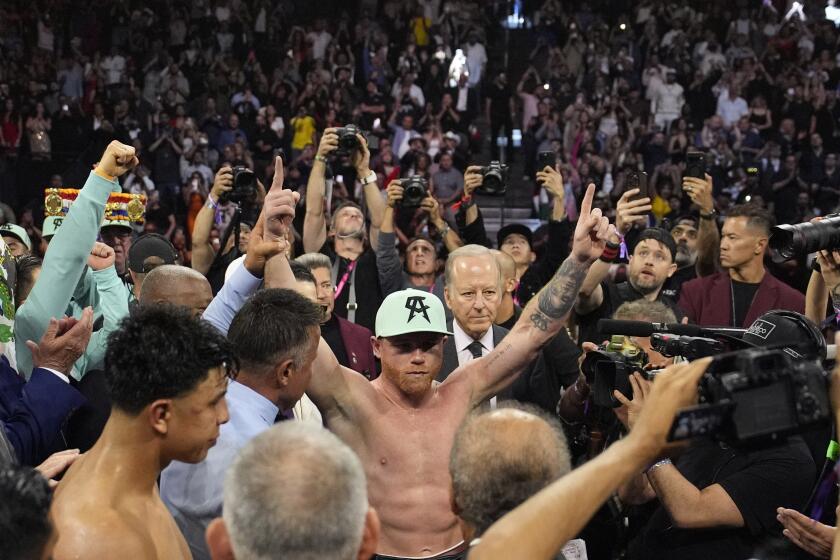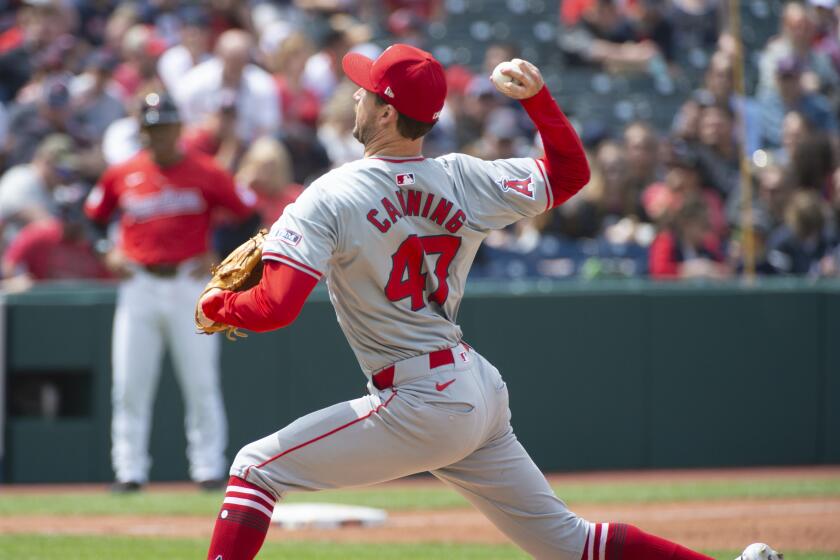Holes Bigger Than Some of Bruin Defense’s Parts
Larry Kerr has been coaching college defenses since 1979 and has tutored several All-Americans and future NFL players.
But in the last two seasons, UCLA has had problems stopping the run, and after last week’s 52-14 loss at Arizona criticism of Kerr’s defense has reached a high.
“Just like anything else, you get too much credit when you play well and when you play poorly you get too much blame,” said Kerr, in his third season as the Bruins’ defensive coordinator. “Obviously, my role is a big role and I have to do a good job on that. But it’s a combination. It’s not all coaching and it’s not all players.”
Against Arizona, there were missed tackles by the dozen and Bruin defenders seemingly were stuck to blockers as if they were magnetized. Through gaping holes, the Wildcats rushed for 315 yards, a six-season high.
“There is no magic pill, because if there was please give me a prescription,” Coach Karl Dorrell said about the Bruins, who are 8-1 and ranked No. 14 in the polls but are 115th out of 119 Division I-A schools in rushing defense, giving up an average of 223.8 yards a game.
Going into Saturday’s game against Arizona State at the Rose Bowl, opponents are averaging 5.1 yards a carry, a far cry from the 3.2-yard average of just two years ago. In 2003, Dorrell’s first season, the Bruins gave up only 317.6 yards of offense per game, second-best in the Pacific 10 Conference.
But two years ago, UCLA’s defense was more experienced and had a lot more size on the line with Rodney Leisle, Ryan Boschetti and Mat and Dave Ball, the conference defensive player of the year.
“That was a special defense that we had,” said senior linebacker Spencer Havner, who started that season as a sophomore. “Most of those guys have gone on to the next level. There’s no denying the talent we had, starting with the big hogs we had up front.”
That 2003 line averaged 6 feet 4 1/2 and 284 pounds, and five starters from that defense -- Matt Ware, Brandon Chillar, Ben Emanuel II, Leisle and Boschetti -- were on NFL rosters last weekend.
“We played a lot of [zone defense] that season and that helped with our production as far as numbers were concerned,” senior cornerback Marcus Cassel said. “Our defensive linemen were a lot bigger then, which helped make that defense work.”
This season’s line averages 6-1 3/4 , 257 pounds, with sophomore tackle Brigham Harwell the biggest at 6-1, 274.
“You have to deal with the parts that you have,” Kerr said. “You’re always trying to get people in there who could do the job. If a guy makes a mistake or two, you have to continue to play him until the point where he can’t get it done or you find somebody else to do it better.”
To offset a lack of size, UCLA often gambles with run-based schemes that leave the Bruins vulnerable against the pass.
“We’ve been fortunate to have our offense pick up the slack, but we know that we have to play better,” senior linebacker Wesley Walker said. “We’re 8-1, so that shows that we’ve been able to get it done like we needed to. But not always.”
The Bruins needed fourth-quarter rallies four times because they could not stop opposing offenses early. Even in more comfortable wins over San Diego State, Oklahoma and Oregon State, they gave up plenty of yardage.
In 2003, Kerr was the coordinator with the right stuff while offensive coordinator Steve Axman was under the gun. After UCLA finished next-to-last in total offense in the Pac-10, Axman was replaced by Tom Cable.
Now Kerr is the target for Internet criticism, and his players say it’s unfair.
“We have to put it on ourselves and just play,” said Havner, who along with Jarrad Page and linebacker Justin London was a starter in 2003. “There are so many schemes that you can dream up, but you have to put in the same effort that you need to make a simple scheme work. That’s something we haven’t necessarily done.”
Page says the Bruins need to use their speed rather than focus on their lack of size.
“If you’re going to sit back and play a zone defense you have to have that bulk up front,” Page said. “That’s not saying anything about our down linemen now because they may be undersized but they’re real athletic.
“We just have to play defense that lets our linemen use their strengths a little more. We are a defense that just goes ... we have to use our speed in order to get there. You can’t change who you are.”
*
BEGIN TEXT OF INFOBOX
Ground down
The bottom of the NCAA Division I-A rankings for defense against the run:
*--* Rank School G Yds YPC YPG 113. Rice 8 1,756 5.8 219.5 114. Eastern Michigan 9 1,981 4.9 220.1 115. UCLA 9 2,014 5.1 223.8 116. Illinois 9 2,028 5.6 225.3 117. North Texas 8 1,805 4.9 225.6 118. East Carolina 8 1,827 4.6 228.4 119. Oklahoma State 8 1,830 5.2 228.8
*--*
More to Read
Get our high school sports newsletter
Prep Rally is devoted to the SoCal high school sports experience, bringing you scores, stories and a behind-the-scenes look at what makes prep sports so popular.
You may occasionally receive promotional content from the Los Angeles Times.






